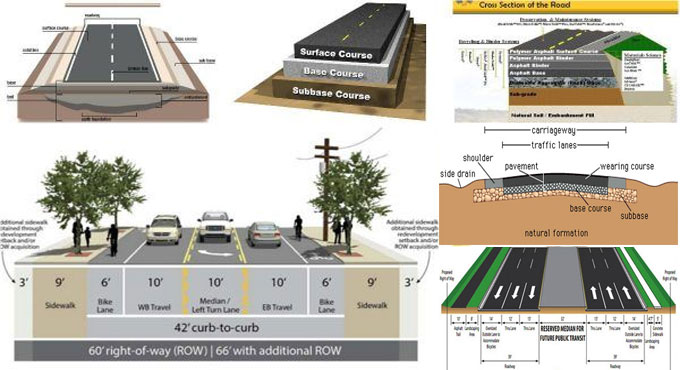NEWS | SOFTWARE | SHEET
Components of Road Structure - Road Construction
Right of Way – Right of way is the region of ground obtained as well as kept for construction as well as formation of road all along its arrangement/alignment.
Furthermore, the width of that obtained ground is known as land width as well as it relies on/depends on the formation width, cuttings’ and embankments’ slope, least sight distance on level/horizontal curves, sewage/drainage system as well as even on the significance of the road and probable potential development.
Formation Width – Is the addition of widths of pavements or carriage way, separators and shoulders if there is.
Road Margins – Are the parts of the ground at any side of the carriageway/road way of a road.
The several components comprised in the road edges/margins are frontage road, transit lane/parking lane, access road/drive way, bicycle path/cycle track, pathway/footpath, embankment slope as well as railings/guard rails.
Pavement or carriage way Width - Carriage way is the roadway’s width built for vehicular traffic’s movement; Carriage way width relies/depends on in the traffic lane’s width as well as number of lane needed. The quantity of lane needed on a highway relies on/depends on expected/predicted as well as transport capacity/traffic capacity of every pathlane. Moreover, the lane width needed is computed in the basic/basis of the vehicle’s width as well as least lateral clearance/side clearance needed with regard to safer drive.
Parking Lane – Those are offered in metropolitan roads to let kerb parking. Moreover, parallel parking must be permitted as long/far as possible. The parking lane width must be adequate.
Frontage Roads – Those are offered to provide access buildings/properties all along a significant highway. Moreover, the frontage road could go along with/ run parallel to the thoroughfare/highway as well as separated by separators.
Drive Way - Those link the thoroughfare/highway with shop/business establishment/commercial establishment such as service centre/station, fuelling/fuel stations and more.
Cycle Track – Those are offered in metropolitan regions wherein the cycle traffic volume on the road is quite significant/high. The minimum width of 2 m is offered for the cycle path/track as well as it could be enhanced by 1 m for every added track.
Footpath (Road’s Components) - In metropolitan region wherein the pedestrian and vehicle/motor traffic are high, footpaths are offered to prevent accidents.
Guard Rails (Road’ Components) - Those are offered at the shoulder edge at the time the road is built on a fill with height greater than 3 m to avert the vehicle from moving/running of the path/track.
Shoulder [Road’ Components] - Those are the road way’s part amid the carriage way’s external peripheries/edges as well as uppermost/top surface peripheries/edges of embankment or interior peripheries/edges of the side drains in lowering/narrowing/cutting. Those are offered all along the road periphery/edge to utilize in an emergency track/lane with regard to/for vehicle needed to be get/taken out of the road/road way or side of the road/pavement.
Shoulder’s minimum width 4.6 m is needed in order that a vehicle station at the shoulder’s part/side might possess a span/clearance of around 1.85 m from the side of the road/pavement periphery/edge.
Side Slopes [Road’s Components] - Those are the slopes offered of the barricade/earth work’s side of the thoroughfare/road in wall/embankment in lowering/narrowing/cutting for its integrity/durability; side slopes within/in the road are in such a way design in regard to maintain the earthwork robust in lowering/narrowing/cutting or in embankment. The soil’s kind/nature in earth work, weather conditions, drainage system/method offered and more or the aspects that have an effect on the side slope’s design.
For additional info view the video:
Lecturer: Civil Study


